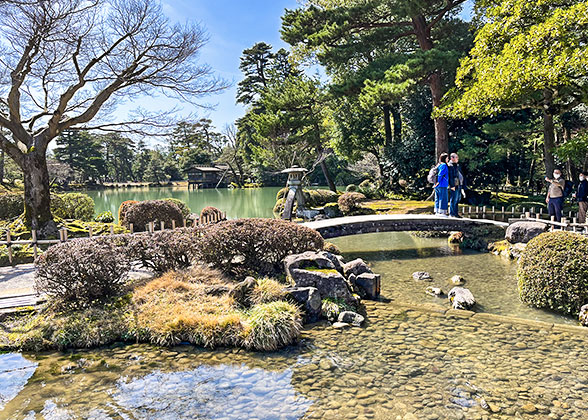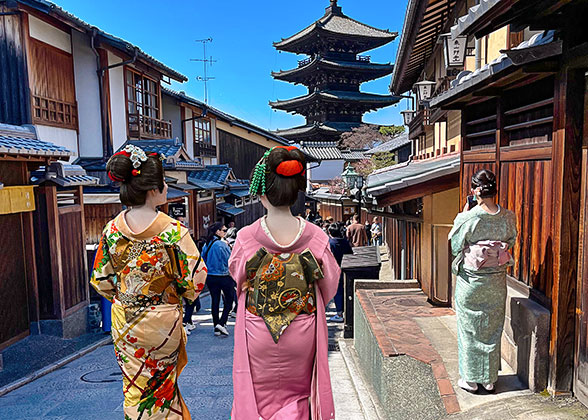- Kenroku-en Garden
- Kanazawa Castle
- Higashichaya Old Town
- Ninjadera
- Omicho Market
Kenroku-en Garden

Kenroku-en Garden Photos ( 28
|
Must-visit Scenic Spots
Fountain
Built in the late Edo period around 1850, the most ancient fountain in Japan can spray water up to 3.5 meters (11 feet) high by taking advantage of terrain difference.Kotoji Stone Lantern
One of the most representative scenery of Kenroku-en Garden is Kotoji Stone Lantern, which is famous for its design of two legs rather than one, whose shape is said to resemble the pillar supporting the string of zither.Flower Viewing Bridge
Flower Viewing Bridge is famous for being suitable to appreciate the flowers around, including cherry, iris and azalea. The most beautiful is the azalea flowers blossoming on the both sides of stream from March to May.Kasumiga-ike Pond
Covering an area of 5,800 square meters (6902 square yards) and with the deepest point of 1.5 meters (4 feet), Kasumiga-ike Pond is the central scenery and the largest pond of Kenroku-en. Around the pond is scattered with scenic spots like Sazae-yama hill, Uchihashi-tei tea house, Kotoji lantern, Niji-bashi bridge, Karasaki pine tree and Horai island, making it very suitable for enjoying scenery.

Kasumiga-ike Pond
|
Chengxun Pavilion
There is a magnificent building at the southeast corner of the garden, which is an imperial Palace built in 1863 by Lord Nariyasu Maeda, an Edo period Japanese samurai, for his mother to live after her retiring. This large two-story building combines two kinds of building styles. The main floor adopts a solemn and formal layout to receive guests while the second floor takes red, blue and purple as its main colors, forming a more entertaining and leisurely atmosphere. Now, Chengxun Pavilion has become a museum where collections like toys, kimonos and drawings are displayed.Magnificent Scenery throughout the Year
Spring - Plum & Cherry Blossoms
|
|
|
After mid-March is the season of cherry blossoms. A total of 20 species and 420 cherry trees are distributed throughout Kenroku-en. The places for enjoying cherry blossoms are as follows:
1. Near the fountain
2. Near Kaiseki Pagoda
3. Near Mayumizaka Gate
4. Kenroku-en Chrysanthemoides
5. Flower Viewing Bridge
Kenroku-en is home to the only Chrysanthemoides tree in Japan, whose flowering period is about 2 weeks, usually from late April to early May each year. Featuring more than 300 petals per flower blossom, this cherry blossom is famous for resembling Chrysanthemum when fully bloomed. Its color will change from deep red to light red, and finally to white.
Summer - Iris, Azalea, Waterfall…
In summer, iris and azalea flowers blossom one after another near Flower Viewing Bridge. You can enjoy the marvelous scenery from the bridge with tranquil water flowing on both sides.You can also wander and enjoy the magnificent scenery while strolling around Kasumiga-ike Pond, where the new green and clear flowing water make you fresh and relaxed.
Midori-taki Waterfall is also worth your time. It can calm your mind in hot weather and make you feel fresh when you hear the sound of the flowing water.
Autumn - Red Maple Leaves, Yukitsuri…

Yukitsuri
|
Another highlight in autumn is the red maple trees. The best time for appreciating maple trees in Kenroku-en is from early November to mid-November. You can immediately see Yamazaki-yama Hill after entering from Kodatsuno Gate, which is covered by maple trees in Autumn, making it a perfect place to take a walk.
If visiting in November, you can also view the operation of adopting umbrella-like ropes to suspend pine trees, so they won’t break by heavy snow in the upcoming winter. When Kenroku-en sets colorful lights to illuminate the trees to match the season of red leaves every year, the pine trees appear to be golden, giving romantic atmosphere.
Hisago-ike Pond is also a great site to visit in Autumn. With red maple trees, Japanese style buildings, waterfalls, and Shiga around, it forms a stunning and picturesque scenery, especially at night after lighting.
Winter - Snow Scenery
If coming to Kenroku-en in winter, you can take a romantic walk around the Kasumiga-ike Pond surrounded by snow-covered scenic spots such as Sazae-yama hill, Uchihashi-tei tea house, Kotoji lantern, Niji-bashi bridge, Karasaki pine tree and Horai island. It’s also a very wonderful experience to search for plum blossoms in mid-February, and enjoy their faint fragrance.Tips
1. There are a total of 7 entrances/ exits in Kenroku-en. The visiting itinerary will be different with different entrances. The entrance most commonly used by tourists is Katsurazaka Gate.2. Kenroku-en holds several lighting activities in some evenings every year, during which it is open for free! One special activity is lighting for cherry blossoms every year from 18:00 to 21:30 in late April for about a week.
3. It is recommended to wear kimonos to visit the most famous Japanese style garden with many ancient buildings with rich historical charm, which must be very romantic if taking some pictures.

Visit Kenroku-en Garden in Kimonos
|
Next to Kenroku-en, there is a kimono rental shop called Kanazawa Kimono Karen. This kimono rental shop offers a “Kanazawa Walk Plan” for 4,330 yen (before tax), allowing you to choose your favorite style from 500 kimono options.
4. After visiting Kenroku-en, you can eat something and have a rest at the teahouse near Hisago-ike Pond.
5. There is a pedestrian street outside the Katsurazaka Gate of Kenroku-en with all kinds of restaurants and cafes standing at two sides where you can enjoy lunch, tea and unique ice cream with gold leaf.
How to Get to Kenroku-en Garden
You can take the circular bus from Station 7, East Exit of Kanazawa Station, and get off at Kenroku-en, which takes about 15 minutes and 200 yen. Then you can see Katsurazaka Gate after walking 2 to 3 minutes along the uphill road.If you want to visit other places or use the bus to return after visiting Kenroku-en, it’s economical to buy a 1-day bus travel voucher at Hokuriku Railroad Ticket Office of Kanazawa Station. It costs 500 yen for adults and 250 yen for children.
Opening Time

An Entrance to Kenroku-en Garden
|
March to October 15: 7:00 to 18:00
October 16 to February: 8:00 to 17:00
Ticket Price

Ticket Center
|
Children (aged 6-18): 80 yen
Seniors aged 65 and above and children under 6: Free of charge
Nearby Attractions
Kenroku-en Garden is connected with Kanazawa Castle. After getting out of the Ishikawa-mon Gate and crossing the bridge, you can arrive at Kanazawa Castle.There are also multiple museums nearby, which can be approached by walking, including Hirosaka 21st Century Museum, Ishikawa Prefectural Museum of Art, Kaga-Yuzen Kimono Center, Kanazawa Noh Museum, where you can deeply explore and experience rich and abundant traditional Japanese culture





